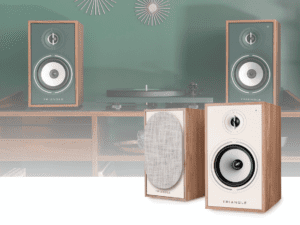
In the audio world, the British are perhaps best known for making great sounding small loudspeakers. It may well be that we are experts in other audio fields (we have a number of excellent turntable makers here, and the UK remains at the forefront of the streaming revolution), but it is small, typically standmount loudspeakers that audiophiles most closely associate with the output of the British Isles. Even today, some the UK’s best-known and most highly respected loudspeaker brands (such as PMC and its Fact 3 featured at the start of this blog) tend to think small.
Why? And why do other countries focus their attentions on bigger loudspeakers with an appropriately bigger, deeper sound?
The easy answer is probably the wrong one. I believe it has nothing whatsoever to do with a ‘national’ sound. We in the UK don’t tend to listen to smaller loudspeakers because we fear bass, any more than people in the US specifically listen for deep bass. It’s not because we spend our lives listening to Elgar, Handel, and the Beatles, any more than US people spend their time listening to Copland, Sousa, and the Beach Boys. What’s more, even if we did, I’m not sure whether that would change the way we listen.
Put simply, it comes down to typical room sizes. The typical UK room is smaller than our European counterparts, and that makes it considerably smaller than the average US room. In part, that comes down to cramming the all the people who live in New York, Florida, Illinois, and Pennsylvania combined into a space slightly smaller than Oregon. But to a large extent, it comes from UK house buyers uniquely selecting their properties by the number of rooms instead of square footage. According to ‘The Case for Space’, a 2011 report by the Royal Institute of British Architects, the average two storey, three-bedroom house in the UK is less than 950 sq ft., which is 86 sq ft smaller than the recommended minimum size required for the five residents that might conceivably occupy this sort of real estate. The figures for new real estate were even worse; the average UK ‘new build’ was under 820 sq ft, where the same new build property in Denmark was closer to 1,500 sq ft.
When faced with people trying to place loudspeakers in a room possibly 10’ wide and 12’ long, it’s little wonder the UK audio market produced small loudspeakers, because the home market couldn’t accommodate anything larger. And it’s little wonder we got good at them. On a purely pragmatic level, if you are a loudspeaker designer living in a country where anything over 1,000 sq ft is considered a ‘big’ house, the chances are you have to live with smaller loudspeakers too.
Traditionally, this room size issue didn’t have too big an effect on the UK high-end market, because those wealthy enough to live outside of the big cities were wealthy enough to buy places with a lot of space. Loudspeakers like large Tannoy horns, and B&W 800s were the result. However, even this is changing; the big money is returning to the big city. London property prices have recently reached a peak, but with property prices in London’s Kensington Palace Gardens achieving more than $10,000 per square foot, devoting nearly $4m for a good-sized room for audio is the stuff of billionaires. That said, if your next-door neighbours are embassies, the Sultan of Brunei, Roman Abramovich, and members of the Saudi royal family, I guess you are probably are a billionaire, so maybe a $4 listening room isn’t beyond the bounds of possibility.
Back on planet Earth, the space management issues UK manufacturers had to face when dealing with the home market are proving successful on the world stage. The audio enthusiasts of Hong Kong and Singapore have similar space issues to those in Western cities, and not everyone is able to squeeze a big loudspeaker into a small room. While sometimes that’s exactly what is needed (I have heard some remarkable sounding systems that manage to successfully squeeze a quart into a pint pot, with large systems in the kind of spaces most US audiophiles would consider too small to be used as a laundry room), all too often you end up with exaggerated bass, overblown imagery and an uneven tonal balance.

The reaction to the ever-shrinking room is fascinating, because across much of the American and continental European audiophile worlds, this issue is not an issue. It simply doesn’t figure. So, some manufacturers just ignore room size issues and build larger systems. I’ve even heard the somewhat dogmatic statement that anyone with a room smaller than 16×20’ shouldn’t bother with good audio, because the room is too much of a compromise. I’m not convinced by this argument, because it’s possible to treat the room and design the system intelligently to minimise and overcome the small-room trade-offs. And that’s why a few companies (such as Wilson Audio with its Duette II) have designed loudspeakers that are designed to work in a smaller environment than most traditional high-end designs.
If the high-end is inexorably moving eastward and to those city dwellers with high-end desires and postage-stamp rooms, we need more products that meet their needs.
High-end audio has broad enough shoulders to accommodate rooms big and small. We shouldn’t focus on one to the exclusion of the other, and I’m not advocating big speaker systems to go away. However, at the moment, we are focusing on one to the exclusion of the other, by not making enough high-end products that work well in a small room.
If you are a city-dweller with designs upon high-end audio here’s the thing; if you have a small room, stop trying to ignore that room, and think carefully before trying to shoe-horn giant systems in there for the sake of showing off. In most cases, you’ll get a better sound from a smaller, well-sorted system.
Tags: FEATURED
By Alan Sircom
More articles from this authorRead Next From Blog
See all
Audio Show Deluxe 2024: A photo show report
- Mar 28, 2024

Paul Messenger 1949-2024: A personal tribute
- Mar 26, 2024

Bristol Hi-Fi Show 2024: See You There!
- Feb 21, 2024

Triangle Borea Connect
- Feb 19, 2024










